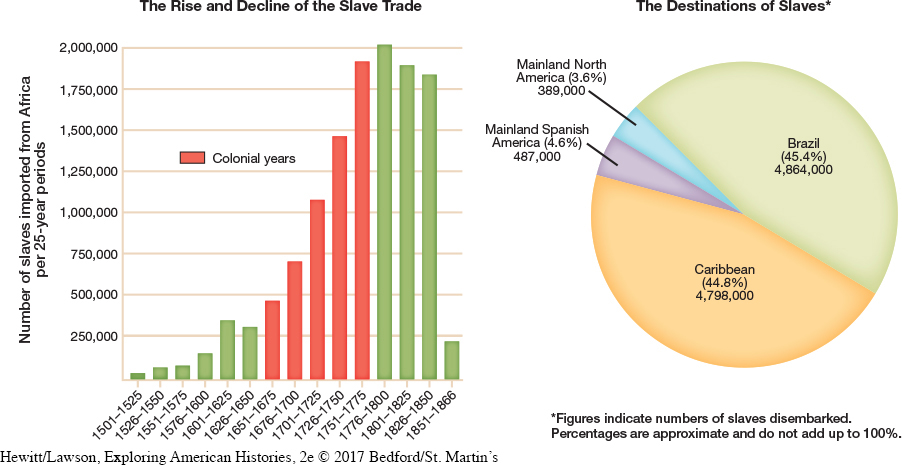The Atlantic Slave Trade
Parliament chartered the Royal African Company in 1672 as it expanded its role in the Atlantic slave trade. Between 1700 and 1808, some 3 million captive Africans were carried on British and Anglo-American ships, about 40 percent of the total of those sold in the Americas in this period (Figure 3.1). Half a million Africans died on the voyage across the Atlantic. Huge numbers also died in Africa, while being marched to the coast or held in forts waiting to be forced aboard ships. Yet despite this astounding death rate, the slave trade yielded enormous profits and had far-reaching consequences: The Africans whom British traders bought and sold transformed labor systems in the colonies, fueled international trade, and enriched merchants, planters, and their families and communities.

European traders worked closely with African merchants to gain their human cargo, trading muskets, metalware, and linen for men, women, and children. Originally many of those sold into slavery were war captives. But by the time British and Anglo-American merchants became central to this notorious trade, their contacts in Africa were procuring labor in any way they could. Over time, African traders moved farther inland to fill the demand, devastating large areas of West Africa, particularly the Congo-Angola region, which supplied some 40 percent of all Atlantic slaves.
Explore
Examine two sources that reveal the horrors of the Middle Passage in Documents 3.2 and 3.3.
The trip across the Atlantic, known as the Middle Passage, was a brutal and often deadly experience for Africans. Exhausted and undernourished by the time they boarded the large oceangoing vessels, the captives were placed in dark and crowded holds. Most had been poked and prodded by slave traders, and some had been branded to ensure that a trader received the exact individuals he had purchased. Once in the hold, they might wait for weeks before the ship finally set sail. By that time, the foul-smelling and crowded hold became a nightmare of disease and despair. There was never sufficient food or fresh water for the captives, and women especially were subject to sexual abuse by crew members. Many captives could not communicate with each other since they spoke different languages, and none of them knew exactly where they were going or what would happen when they arrived.
Those who survived the voyage were likely to find themselves in the slave markets of Barbados or Jamaica, where they were put on display for potential buyers. Once purchased, the slaves went through a period of seasoning as they regained their strength, became accustomed to their new environment, and learned commands in a new language. Some did not survive seasoning, falling prey to malnutrition and disease or committing suicide. Others adapted to the new circumstances and adopted enough European or British ways to carry on even as they sought means to resist the shocking and oppressive conditions.
Exploring American HistoriesPrinted Page 85
Exploring American Histories Value EditionPrinted Page 64
Chapter Timeline